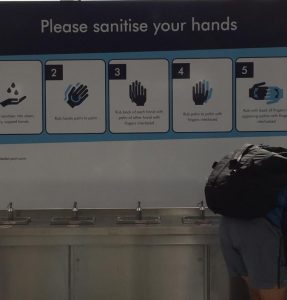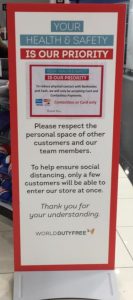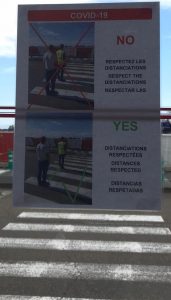Flying from the UK to France – does this give us a preview of post-COVID travel at large?
In recent months we have had a lot of enquiries about education materials related to advice for travel in the post COVID-19 world. We had no plans to change our foundation course material, but instead we are considering producing a short supplementary course or animation that will be equally valid for domestic and international travel.
The travel landscape seems to be incredibly fluid at the moment and in the absence of international standards, individual companies (whether airline, ground transport or hotel) seem to be applying measures[1] that balance the need to get operational again, allay customer fears, be seen to be doing the right thing and to differentiate just enough from their competitors to attract custom. Will these individual measures, combined with an increase in travel, override a need for international standards?
During the lockdown, a former colleague flew from Australia to Uganda (via UK and Ethiopia) to take up a role with the UN and found the experience to be eerily quiet but not significantly different to travel of old. Not being able to get a coffee at Heathrow during his 9 hour layover his biggest hardship[2].
Last week friends of one of our team, Justine Oliver, travelled to Biarritz[3] in south west France and kindly answered a few questions for us about their experience. Please note that this account is based on their personal observations, if they missed procedures or advice at any stage it was not obvious to them.
1. Booking: There were no checks or questions as to whether any of the travellers had had COVID, had been tested or were at risk. There were links to various resources and information sources about the virus. No extra information was provided with the booking, just links. They looked at the airport website to see if they would need extra time and it mentioned cleaning and physical distancing measures they had in place – but no advice on whether you needed to leave extra time.
2. Online check in: No changes aside from a requirement to tick a box saying you had read the COVID advice.
3. Arrival at airport: They drove and not all car parks were open due to the low volume of travellers, theirs was within walking distance of the terminal, so no observation of any measures during transit.
 4. Check in hall: It was relatively empty, everyone wore face coverings, there were a lot of signs related to expected behaviour, physical distancing and hygiene. and guides to maintain physical distance and hand sanitiser stations. There were enough staff to ensure that people were physically distancing in queues and managed this process efficiently and politely. They noticed that a few people weren’t wearing masks and no one seemed to be enforcing that they should. There are vending machines to buy masks if you didn’t have one. There were no screening checks (at any point in process) and no questions asked about your health.
4. Check in hall: It was relatively empty, everyone wore face coverings, there were a lot of signs related to expected behaviour, physical distancing and hygiene. and guides to maintain physical distance and hand sanitiser stations. There were enough staff to ensure that people were physically distancing in queues and managed this process efficiently and politely. They noticed that a few people weren’t wearing masks and no one seemed to be enforcing that they should. There are vending machines to buy masks if you didn’t have one. There were no screening checks (at any point in process) and no questions asked about your health.
5. Security screening: The security area had been screened and each traveller had their own booth to load their luggage onto the conveyor belt. Trays were being collected and cleaned by staff before being returned to the front. Hand sanitiser stations were provided.
6. Waiting airside: Duty free was open, as were the newsagents and pharmacies. All other shops, restaurants and cafes were closed. All seats were available to sit on, but with signs recommending social distancing. Toilets were open, with 1m distancing signs.
7. Transit to gate: They walked to the gate so noticed nothing unusual.
 8. Boarding: They noticed nothing different about boarding, the plane was quite full, there was no attempt at social distancing in the hall, passports were physically handed over to be checked (taken with gloved hands). Waiting on the tarmac to enter the aircraft people did physical distance in their groups, but this was not controlled.
8. Boarding: They noticed nothing different about boarding, the plane was quite full, there was no attempt at social distancing in the hall, passports were physically handed over to be checked (taken with gloved hands). Waiting on the tarmac to enter the aircraft people did physical distance in their groups, but this was not controlled.
9. Flight: boarding was done at random, there was no back to front loading. There were regular reminders to wear your face covering (unless under 12). There was trolley service, but only pre-sealed snacks and drinks. To go to the toilet you needed to alert the staff and they would escort people to prevent queues building up.
10. Arrival: There was no control over exiting the aircraft or social distancing measures on the way to and entering the airport.
 11. Immigration: Passports handed over and no questions asked about possible past contact with the virus and no questions asked about final destination or quarantine. “The same as normal but with masks”.
11. Immigration: Passports handed over and no questions asked about possible past contact with the virus and no questions asked about final destination or quarantine. “The same as normal but with masks”.
Their overall impression was that the measures were appropriate and reassuring, however they felt that if the capacity increased to near normal levels the measures would be inadequate. It was surprisingly easy, they were expecting more questions, more forms and more time-consuming measures. They were impressed that nearly everyone wore a face covering through the whole process.
This is only one journey and right at the beginning of travel starting again, so perhaps we can’t make any predictions based on it, however it does point to measures evolving to match demand/habits and the path of the pandemic. At the moment, best practice would suggest enhanced personal hygiene, wearing a face covering and adhering to social distancing rules, at all times; whilst following any local instructions that go beyond this. Carrying you own hand sanitiser and bringing cleaning wipes would also be circumspect. https://betravelwise.com/covid-19-awareness/
UPDATE on 10th July
Travellers a week later on this same route made these observations:
a. They received an email from the airline, post-booking, with guidance and instructions for airport procedures, what to expect on the plane and general COVID-19 safety.
b. They saw groups of people at the airport being instructed to wear masks when seen without them.
c. Some of the seats in the waiting area had been cordoned off. The airport was still relatively empty and they felt that it would be inadequate without shops and restaurants being opened. Some passengers were taking seating out of (closed) restaurants to use.
d. People on the plane were using the loo without alerting staff, announcements said to try not to use them, but no action was taken.
UPDATE on 11th July
e. The airline sent out emails with notification from the British Government that all passengers entering the UK were required to complete the passenger locator form: https://www.gov.uk/provide-journey-contact-details-before-travel-uk
____________________________________________
[1] This article describes the differences between the 4 major airlines in the United States and the airport procedures associated with each: https://www.businessinsider.com/what-to-expect-when-flying-on-united-american-delta-southwest-during-pandemic-comparison-2020-7?r=US&IR=T
[2] Aside from 8 days quarantine while transiting through Addis Ababa
[3] They travelled from Stanstead direct to Biarritz with Ryanair
10th July 2020